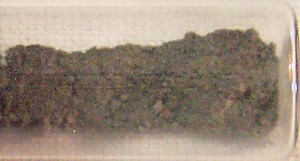Ruthenium
 |
| Name | Ruthenium |
| Symbol | Ru |
| Atomic Number | 44 |
| Atomic Mass | 101.07 atomic mass units |
| Number of Protons | 44 |
| Number of Neutrons | 57 |
| Number of Electrons | 44 |
| Melting Point | 2250.0° C |
| Boiling Point | 3900.0° C |
| Density | 12.2 grams per cubic centimeter |
| Normal Phase | Solid |
| Family | Transition Metals |
| Period | 5 |
| Cost | $1286 per kilogram |
| Origin of Name | From the Latin word Ruthenia, meaning Russia |
| Date and Place of Discovery | In 1844 in the Ural Mountains in Russia |
| Discovered by | Karl Karlovich Klaus |
| Common Compounds |
|
| Interesting facts |
|
| Common Uses |
|
Photo Courtesy of About.com |
| Ruthenium Atomic Structure | Elements by Name | Elements by Number | Home |